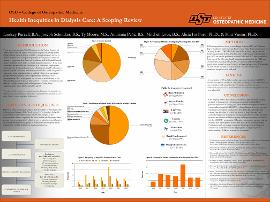| dc.contributor.author | Purcell, Lindsey | |
| dc.contributor.author | Schnitker, Joseph | |
| dc.contributor.author | Moore, Ty | |
| dc.contributor.author | Peña, Andriana | |
| dc.contributor.author | Love, Mitchell | |
| dc.contributor.author | Ford, Alicia Ito | |
| dc.contributor.author | Vassar, Matt | |
| dc.date.accessioned | 2023-11-02T20:47:18Z | |
| dc.date.available | 2023-11-02T20:47:18Z | |
| dc.date.issued | 2023-02-17 | |
| dc.identifier | ouhd_Purcell_healthinequitiesindialysiscare_2023 | |
| dc.identifier.citation | Purcell, L., Schnitker, J., Moore, T., Peña, A., Love, M., Ford, A. I., and Vassar, M. (2023, February 17). Health inequities in dialysis care: A scoping review. Poster presented at Research Week, Oklahoma State University Center for Health Sciences, Tulsa, Ok. | |
| dc.identifier.uri | https://hdl.handle.net/11244/339943 | |
| dc.description.abstract | Background: Dialysis is a life-sustaining treatment that thousands of Americans with end-stage renal disease (ESRD) rely upon. Understanding the health inequities that exist within dialysis treatment is integral to the improvement of care — especially for those in historically marginalized groups. Our scoping review’s objective was to identify potential gaps in the current literature on inequities in dialysis as well as explore future research that could contribute to more equitable care. | |
| dc.description.abstract | Methods: Following guidelines from the Joanna Briggs Institute (JBI) and the Preferred Reporting Items for Systematic reviews and Meta Analyses extension for Scoping Reviews (PRISMA-ScR), we conducted a scoping review of health inequities in dialysis. PubMed and Ovid Embase were searched in July 2022 for articles published between 2016 and 2022 that examined at least one of the following health inequities as defined by the NIH: race and ethnicity, sex or gender, LGBTQ+ identity, underserved rural populations, education level, income, and occupation status. Frequencies of each health inequity as well as trends over time of the 4 most examined inequities were analyzed. | |
| dc.description.abstract | Results: In our sample of 69 included studies, gaps were identified in LGBTQ+ identity and patient education. Inequities pertaining to race and ethnicity, sex or gender, underserved rural populations, and income were sufficiently reported. No trends between inequities investigated over time were identified. | |
| dc.description.abstract | Conclusions: Our scoping review examined current literature on health inequities pertaining to dialysis and found gaps concerning LGBTQ+ and patients with lower levels of education. To help fill these gaps, and possibly alleviate additional burden to these patients, we recommend cultural competency training for providers and dialysis center staff as well as community-based educational programs to improve dialysis patients’ health literacy. | |
| dc.format | application/pdf | |
| dc.language | en_US | |
| dc.publisher | Oklahoma State University Center for Health Sciences | |
| dc.rights | The author(s) retain the copyright or have the right to deposit the item giving the Oklahoma State University Library a limited, non-exclusive right to share this material in its institutional repository. Contact Digital Resources and Discovery Services at lib-dls@okstate.edu or 405-744-9161 for the permission policy on the use, reproduction or distribution of this material. | |
| dc.title | Health inequities in dialysis care: A scoping review | |
| osu.filename | ouhd_Purcell_healthinequitiesindialysiscare_2023.pdf | |
| dc.type.genre | Presentation | |
| dc.type.material | Text | |
| dc.subject.keywords | dialysis | |
| dc.subject.keywords | inequities | |
| dc.subject.keywords | access | |
| dc.subject.keywords | outcomes | |
